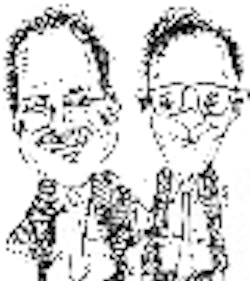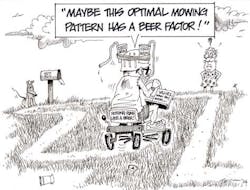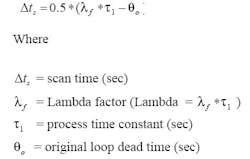The best of the best Part 2
Stan: We continue our multi-part series of interviews with the big names in process control people we personally know. This time we talk with ISA Fellow Bob Otto.
Greg: What are the two applications you worked on with biggest benefits?
Bob: First was a process control computer that became one of three products that enabled Monsanto to merge with Fisher Controls and bring Fisher into the control room. The product called DC2 was a tremendous technical challenge. At the time, mass-memory devices such as disk drives were not available; no operating system was appropriate (UNIX was a fledgling); and the only I/O devices available were card reader/punches and teletypewriters with paper tape. We didn’t think card readers would last in the control room so a teletypewriter at fifteen characters per second was the only choice. We ended up having to work with an all-RAM computer driven by a teletypewriter (also the operator’s console) and no operating system.
This Month's Puzzler
Can You Concentrate?
What problems would you expect when a PID controller is used for concentration control of a process with a dead time of 120 minutes and a time constant of 60 minutes?
Send an e-mail with your answer, questions, or comments to The Puzzler.
We developed a computer with a BASIC interpreter wired into read-only memory (ROM). And wired it was! Eight Kbytes hand-wired bit by bit. I developed extensions to BASIC, such as process I/O, that made it a rather sophisticated digital process controller even though you had to do everything yourself, including the PID algorithm. It was among the first computers to have a BASIC compiler in ROM.
A second item came in the early 1980s, when I was bowled over by Charlie Cutler’s Dynamic Matrix Control (DMC) paper. I wrote an internal report on how to implement it in detail, and I modified it to be suitable for chemical process control rather than petroleum operations. A Monsanto colleague, Mark Sowell, applied it for concentration control of a process with a dead time of 120 minutes and a time constant of 60 minutes (settling time of 9 hours) with great results.
Greg: What were some of your greatest technical achievements in process control?
Bob: I am proud of the decoupler I developed for the control of the firing pattern in an ammonia reform furnace. The reform furnace consisted of sheets of tubes with a row of burners in between two sheets. The hotter you could run the tubes, the greater the efficiency of the furnace. Unfortunately, one row of burners would heat two sheets! I developed a matrix that represented the influence of each row of burners on the adjacent sheet exit temperatures and then inverted it to allow the algorithm to manipulate the burner valves to compensate for temperature deviations in the sheet-exit temperatures. The control system kept the exit temperatures of all sheets uniform thus allowing operation of all sheets at the maximum temperature. Without the control the hottest sheet would determine the limit of operation.
Maybe not the greatest, but the most satisfying one was the Williams-Otto process control model. It was my second or third job at Monsanto. Ted Williams, Director Emeritus of Purdue, was my boss at the time, and he suggested developing such a model. I designed the reactor, and Ted designed the distillation column. The design posed severe problems that gave two or three decades of chemical engineering students practice in the control of unstable processes and distillation columns.
Greg: What are the two greatest opportunities in process control today?
Bob: I agree with Terry Tolliver that fieldbus instrumentation opens huge opportunities in today’s process control. An application presented at last fall’s ISA Expo was eye-popping. The second opportunity is to use the speed of today’s computers for elaborate process simulations.
Greg: Bob is the most enthusiastic supporter of advancing control technology. There has been significant validation of his vision that small model predictive controllers integrated in distributed control systems would prove useful for systems where there is a need to deal with interactions or large dead-time-to-time-constant ratios and provide first level optimization.
Stan: Glenn Givens answered the October puzzler that asked what wireless communication interval would start to cause a degradation in control for a loop with a small dead-time-to-time-constant ratio tuned with a Lambda factor of 2.
He says, "By ‘wireless communication interval,’ I’ll assume you mean ‘control period.’ You should see degradation when the control period is greater than or equal to 1/3 of the time constant (in this case, 1/6 of Lambda). I think you should have at least four control actions within the main time constant."
Greg: There is certainly a quite noticeable loss in information for a scan or communication interval greater than 1/3 of the process time constant that would play havoc with process analysis. The ability to reject a load disturbance at the process input does not deteriorate much until the scan time approaches 1/2 the Lambda, minus the original dead time (Lambda is the product of the Lambda factor and the process time constant). For dead-time-dominant processes (dead time greater than time constant), the deterioration would set in at 1/3 of the time constant, as Glenn noted, or even sooner. See www.controlglobal.com. The peak error is actually worse than shown in these figures for large communication intervals due to the loss of information. An instantaneous measurement should have been included in the trends.
Stan: We conclude on a lighter note with a Top Ten List from our ISA book, Dispersing Heat Through Conviction.
Top Ten Signs You Are a Process Control Engineer
10. Your first and second language is for a computer.
9. You have photos of pH electrodes in your wallet.
8. Your riding lawn mower has a laptop holder.
7. Your laptop has a beer cup holder.
6. You have more muscles in your fingers than in the rest of your body.
5. You have X-rated pictures of people doing strange things with obsolete DCS consoles.
4. You dream "Baywatch" life guards wear hard hats and carry laptops.
3. You named your children ‘Lightning’ and ’Thunder’ after DCS releases.
2. You are frustrated with noise band and dead time in your peer 360-degree feedback.
1. You have hired a private investigator to determine who gave your life to Dilbert.
Additional PDF Downloads:
Forward Modeling Controllers
Scan Time Effect on Load IAE
Scan Time Test
| About the Authors |
Greg McMillan and Stan Weiner, PE, bring their wits and more than 66 years of process control experience to bear on your questions, comments and problems. Write to them at [email protected].




